The Multimillion-Dollar Head Fake is an investigative project by Jay Rosenstein, a University of Illinois professor of Media and Cinema Studies, on how the University of Illinois spends state money on its athletic department despite claims to the contrary.
Below is the series as presented on Rosenstein’s website. It was also featured in the Huffington Post, the Champaign News Gazette, Illinois Public Media and the Chicago Tribune.
“Intercollegiate Athletics (at the U of I) is self supported and does not use state funds, taxpayer dollars, or university funds for our salary program.”
– Kent Brown, UI Athletic Department spokesperson
How many times have you heard that before? Have you ever wondered if it’s true?
It’s not. And here are all the details.
THE MULTIMILLION-DOLLAR HEAD FAKE is the most in-depth and revealing investigation into the inner-finances of the University of Illinois, Urbana Athletic Department ever conducted. Read it. It’s in four parts.
Part One
‘No Taxpayer Dollars’ For Coaches At the U of I? It’s a Lie
by Jay Rosenstein
“It’s not tax money, so angry taxpayers can calm down.” That was the first reader comment posted on an on-line Chicago Tribune story.
The issue that elicited that reaction was the six-year, $18 million contract for newly hired University of Illinois, Urbana head men’s basketball coach Brad Underwood. It’s part of a familiar ritual that happens whenever the UI hires a new high-profile coach:
– “This doesn’t come out of tuition. It doesn’t come out of state funding. It’s strictly out of athletic funds,” said UI Trustee Edward McMillan in a newspaper story after a new coaching hire.
– “Coaching contracts are covered by athletic department income, not tuition or state funds,” noted UI Trustee Timothy Koritz.
– “The state of Illinois does not fund coaches’ salaries,” said official UI spokesperson Robin Kaler.
– “Intercollegiate Athletics is self supported and does not use state funds, taxpayer dollars, or university funds for our salary program,” said Kent Brown, athletic department spokesperson.
It’s a narrative that’s been repeated for years, over and over, from pretty much every corner.
Except it’s not true.
While taxpayer money doesn’t technically go to pay the coaches’ actual salary lines, taxpayer money does pay for the salary packages for most every UI coach, trainer, and full-time athletic department staff member. That’s because UI athletic department employees are UI employees, so they receive the same “standard university benefits” as all other UI employees.
And benefits for UI employees – health, dental, etc. – are paid for by the state of Illinois. In other words, the taxpayers.
The cost isn’t exactly trivial. In 2016-17, the taxpayers’ bill for athletic department benefits was just under $6 million, according to the UI’s Associate Chancellor for Public Affairs. And the cost of those benefits is an annual expense. Combined with the $2.6 million pension cost for retired coaches and other retired athletic department employees (as explained in Part Two of this series), the total cost to Illinois taxpayers for UI athletic department compensation packages was $8.6 million in 2016.
Yet according to U of I Trustee Tim Koritz, “coaching contracts are covered by athletic department income, not tuition or state funds.”
Maybe in Trumpworld of alternative facts.
“What I think it does is it undercuts the argument that tax dollars have nothing to do with athletics,” said State Senator Scott Bennett. “They certainly do.“
Even if taxpayer money isn’t going directly to pay these incredibly generous salaries, it still plays a role. By picking up the cost of employee benefits for the UI athletic department, taxpayers help to free up money for the athletic department, money it can then use to pay for other things – such as the salaries of its coaches. Those huge salaries — football coach Lovie Smith and men’s basketball coach Brad Underwood are the highest paid public employees in the state — ought to look very different to the public when it knows that part of the justification for those salaries, that “the state of Illinois does not fund coaches’ salaries” is basically a lie.
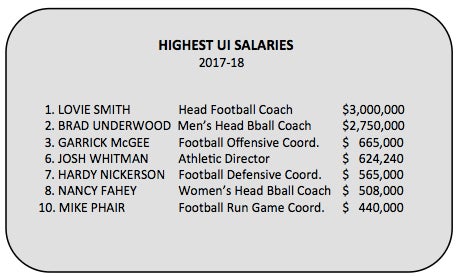
All data from U of I Academic Personnel Book
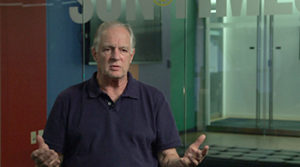
“There’s so many people in an athletic department (today), it’s incredible. I mean, literally incredible,” said Rick Telander, a sports journalist who has been covering college sports for more than forty years. “There are no limits. There’s no cap.”
Like many of its peers, the UI athletic department has grown dramatically. The total number of athletic department staff, according to the university’s academic personnel books, has risen from eighty-eight in 1997, to one hundred and ninety-six in 2017. That’s a whopping one hundred and twenty three percent increase (+123%) in athletic staff. (Compare that with the number of tenured faculty, which is basically unchanged over that same twenty years, while the total number of students has increased by 25%).
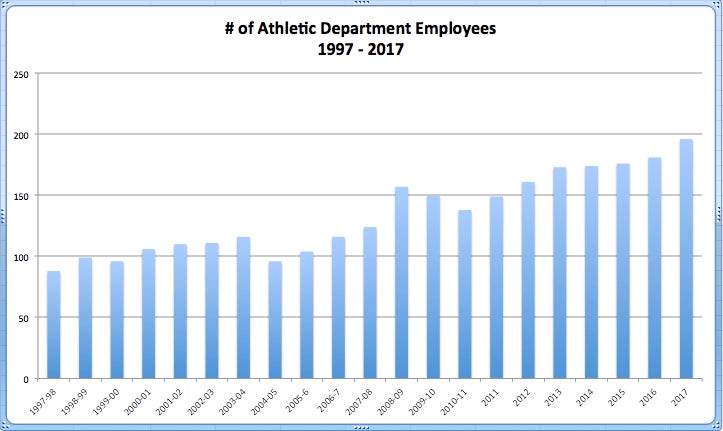
Data from the University of Illinois Academic Personnel “Gray” Books
More staff costs taxpayers more money. New hires add to the total benefit costs that Illinois taxpayers have to pay. As long as TV revenue for broadcast rights continues to grow as it has, the number of athletic department employees is likely to grow with it. It’s strangely ironic that the more TV money the UI athletic department gets, the more it could actually end up costing the taxpayers.
Of course, the athletic department doesn’t have to hire more staff. The number of sports offered by the UI hasn’t changed for decades. But no one seems to be willing to ask the simple question: why does athletics really need to keep hiring more people? Maybe it’s because we already know the answer: because everyone else is doing it.
And unfortunately the even more important follow-up question is never asked either: since athletics keeps getting more and more revenue, why can’t it pay the benefits for its own employees instead of the taxpayers?
That answer is easy too. Because we allow it to happen, that’s why.
And why do we allow it to happen? Perhaps because we believe these statements:
— “This doesn’t come out of tuition. It doesn’t come out of state funding. It’s strictly out of athletic funds.”
–“Coaching contracts are covered by athletic department income, not tuition or state funds.”
–“The state of Illinois does not fund coaches’ salaries.”
–“Intercollegiate Athletics is self supported and does not use state funds, taxpayer dollars, or university funds for our salary program.”
Alternative facts. And round and round it goes.
Don’t believe it.
Part Two
U of I Athletic Director Gets a Raise, Taxpayers Get a Bill
by Jay Rosenstein
When former University of Illinois Athletic Director Ron Guenther was earning a relatively modest $340,000 a year in 2003, no one really paid much attention. Nor were any red flags raised when, five years later, his salary ballooned to $600,000 a year.
After all, the public was regularly assured, UI athletics ”does not use taxpayer dollars for (its) salary program.” So why would taxpayers worry about Guenther’s salary?
Maybe because of what’s happened since he retired.
Today, just six years after his retirement, former UI, Urbana Athletic Director Ron Guenther is collecting an almost unbelievable $473,094 annual pension.
And Illinois taxpayers are paying every penny.
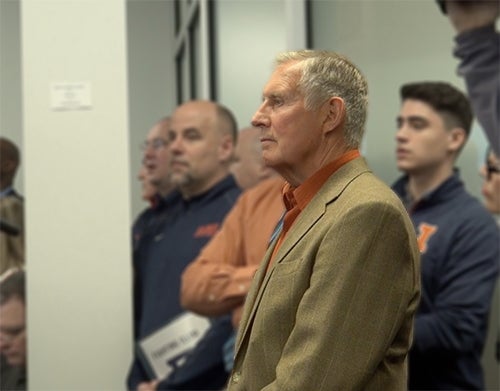
Former UI Athletic Director Ron Guenther attends the press conference announcing the hiring of Lovie Smith. Photo © 2016 Jay Rosenstein
Guenther is not alone. A recent investigation shows that retired coaches and administrators from the athletic department at the UI’s Urbana campus cost Illinois taxpayers more than $2.6 million per year in pensions. Add in a guaranteed three percent annual cost of living increase, and that total is almost certain to rise every year.
All from a department whose salaries we were consistently told cost the taxpayers nothing.
There are plenty of familiar names on the list of retired athletic department employees currently drawing big pensions. After Guenther, the next highest pension belongs to legendary former U of I men’s head basketball coach Lou Henson. Despite earning a relatively modest salary throughout his Illinois coaching career, Henson’s pension is currently $347,058 per year, the 17th highest for all state university employees. That’s more than he ever made per year in salary as the head coach.
Other notable taxpayer-funded athletic pensions (all rounded to the nearest thousand) include former UI head baseball coach Richard “Itch” Jones ($173,000), former UI assistant basketball coaches Jimmy Collins ($200,000), Mark Coomes ($129,000), and Richard “Dick” Nagy ($109,000). And remember the woman who was going to put the UI women’s basketball team on the national map, the long-since departed women’s head basketball coach Theresa Grentz? You should, because we’re paying her more than $116,000 per year.
So, how did this happen? Like all benefit-eligible U of I employees, Guenther and others in the UI athletic department are enrolled in the State Universities Retirement System, or SURS. All SURS members are required to pay 8% of their salaries into the system. That 8% contribution, plus interest, accrues in each employee’s account.
When Guenther retired in 2011, his account contained a total of $614,647 from his contributions plus interest. By 2015 he had collected more in total pension from SURS than he had accumulated in his account.
More than anything, it’s the huge salary increases that Guenther received at the tail end of his career that created his outsized pension. An employee’s SURS pension is based on several factors: years employed, age at retirement, and the average of the highest four consecutive years of salaries. Every time a coach or an athletic department employee’s salary goes up, their potential pension goes up too.
So, in effect, every time Guenther was handed a raise, the Illinois taxpayers were handed a bill.
Keep that in mind every time the U of I Board of Trustees approves a huge raise or bonus for another U of I coach.
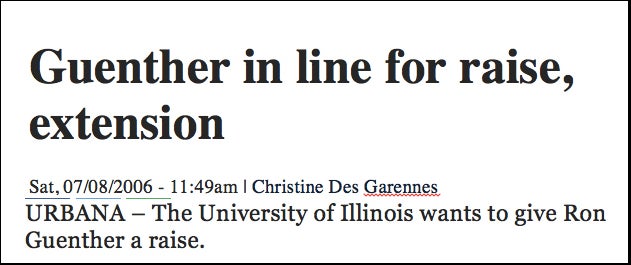
Headline from a 2006 Champaign News Gazette story about a $90,000 a year raise for Ron Guenther. That raise handed taxpayers a bill for at least $56,000 a year for the rest of Guenther’s life.
While a total of more than $2.6 million in taxpayer-funded pensions are being paid to retired U of I athletic department employees (see table below), the actual annual total is undoubtedly much higher. That’s because SURS doesn’t record information about the retiree’s former unit or department, so it’s impossible to search the SURS database to identify former athletic department employees. No doubt there are more retired athletic department members than just the eighteen below whose pensions add up to the $2.6 million total.
This news comes at a particularly bad time for Illinois’ state universities, which saw significant losses in state funding due to the state’s two year inability to pass a budget, and even with a new state budget face an uncertain future with respect to state support. Seeing the amount of state money being used to pay Guenther’s and other retired coaches’ huge pensions, while at the same time seeing the amount of state money being used to support the U of I shrink, is sure to rankle the school’s faculty and staff, not to mention tuition-paying parents and students.
And perhaps even the Illinois taxpayers, the people who are ultimately left holding the bill.
———————————————————————————————————————-
Pensions for Select Retired UI Athletic Department Staff

Sources: SURS, Better Government Association
Author’s note: the abbreviation UI is used to indicate the University of Illinois, Urbana campus
Part Three
The Athletic Fee That Isn’t There. Except It Is
by Jay Rosenstein
In April of 1997, the University of Illinois, Urbana athletic department was in big trouble.
It found itself in a $1.4 million hole, and budget projections showed that the department would continue to run that deficit each year well into the future. “What’s alarming,” said the Chancellor’s liaison to athletics at the time, “is that even under the best-case scenario, we end up with a deficit.”
The Board of Trustees decided that immediate action was necessary.
After much discussion, they chose a solution: a mandatory student fee for the athletic department, primarily to help pay off the debt for remodeling the football stadium five years prior. It would be the first such fee in University of Illinois, Urbana history.
“What alternatives do we have?” asked then-Trustee Tom Lamont, quoted in a Champaign News Gazette story. “I submit to you that we have none. And it is a responsibility in which students must share.”
But the students disagreed. In a student referendum held a little over a week before the Board was set to approve the fee, students voted against the new athletic fee by a landslide margin – 88% to 12%. The then-Student Body President remarked that she couldn’t recall another issue that lost by such a wide margin.
But it made little difference. Eight days later, at their regular monthly meeting, amid protests by students who packed the meeting room, the U of I Board of Trustees instituted a mandatory $34 per semester per student fee to help balance the athletic department’s budget.
Twenty years later, that fee is still there. Illinois students are still paying it.
The budget problem that the fee was originally meant to fix has long since disappeared. Yet the fee has never been revisited by the student committee that evaluates student fees or the student government, or publicly by the university administration or the Board of Trustees. Most students aren’t even aware that they’re paying the fee, let alone what it’s for, or how it got there in the first place.
And how could they? The athletic fee doesn’t even appear by name on their university bills.
It’s virtually disappeared, buried and hiding. Except it’s still there.
The mysterious student athletic fee is just one of the findings uncovered as part of an in-depth, multi-year investigation into the way the University of Illinois, Urbana funds its athletic department.
FINANCIAL CONDITIONS CHANGE, BUT THE FEE DOESN’T
The 1997 athletic fee was instituted based on projections that the UI athletic department was on an unavoidable path of constant debt. But in the ensuing years, some unexpected developments changed all that, and the fortunes of the athletic department improved dramatically.
In 2006, the UI’s athletic conference, the Big Ten, created the first television network just for an individual conference. It has proven to be a cash cow, flooding the conference’s schools with unexpected new money. Revenue to the UI athletic department has more than doubled, from $45 million in 2004 (the first year totals are available), to just over $96 million in 2016.
Twenty years earlier, students had predicted this possibility. In the debates leading up to the approval of the 1997 fee, according to a newspaper account, students asked the Board of Trustees for a cap on the length of time the fee would be on the books, “so that if the athletic department develops a budget surplus, the fee could be reduced or discontinued.”
Then-trustee Tom Lamont promised that the board would review athletic finances annually, and if the department ran a surplus for five years, the fee could probably be reduced. But he scoffed at that possibility. “I think it’s unrealistic to expect that we will somehow find our (athletic) budget bloated with excess revenues,” he said in the same newspaper story, labeling that scenario as “dreamland.”
But dreamland did, in fact, arrive. For nine consecutive years, from 2005 to 2013, the athletic department ran a surplus. But Mr. Lamont and the other trustees from 1997 were long gone from the Board, and any deals or promises made at the time were forgotten. The students who had protested the fee at the time were long gone too.
All that’s left is the fee. It’s still there.
MORE STUDENTS, MORE MONEY
The 1997 student athletic fee was created to pay for a $1.4 million-a-year athletic department expense for the financing of the 1992 renovation of Memorial Stadium (the football stadium), as well as some smaller remodel costs for a few other athletic buildings. Based on the number of students at the time, the Board calculated that charging $34 per student per semester would yield the necessary $1.4 million total, which would, a newspaper article read, remove “that cost from the Division of Intercollegiate Athletics budget … thus erasing its deficit.”
But a funny thing happened to the UI on the way to erasing its athletic deficit.
The student body grew, significantly. And the total amount of money collected from the $34 per student per semester fee grew significantly too. Today, the fee that was originally created to erase a $1.4 million debt is generating just over $3.2 million in revenue, more than double the original amount. It’s turned out to be an unexpected financial windfall.
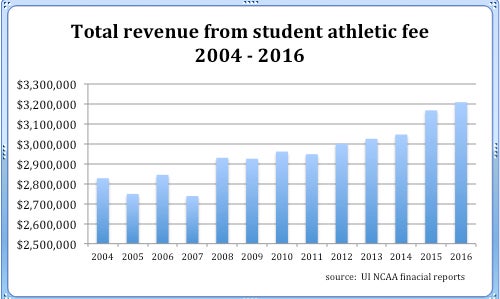
The original student protestors of the fee would have seen this as the perfect time to reduce it, just as they had asked. But instead, the university took the fee, and quietly, shifted it to pay for something else.
In 2006, the UI athletic department had undertaken another football stadium renovation, this one far bigger, and at $104 million, far more expensive than the previous one. The money for this renovation would be used to build, according to the bond issue documents, “48 18-seat luxury suites, approximately 202 (premium) indoor club seats and 1,136 (premium) outdoor club seats.”
And the 1997 student fee, the one created to pay off the 1992 football stadium renovation, was now going to help pay for this new renovation.
“That … was largely a renovation that benefited those sitting in luxury seating,” said State Senator Scott Bennett, whose district includes UI, when he learned about the fee. “So that one is particularly egregious because the people that it’s really benefiting (are the ones) who should be paying for it. Not students who are never going to see the inside of it.”
But the students did get something in the deal, other than the usual student ticket discount. In a 2013 News Gazette newspaper story, the UI associate vice president for planning and budgeting “noted that the project included a new student section at the north end of the stadium.”
Not noted was what the students gave up, or more accurately, what was taken away – the old student section, located in the stadium’s sweet spot on the fifty-yard-line. They were instead relocated behind the end zone, historically some of the most difficult seats to sell. In other words, the renovation moved the student section from the best seats in the house to some of the worst.
And the students paid, and are still paying, for that privilege.
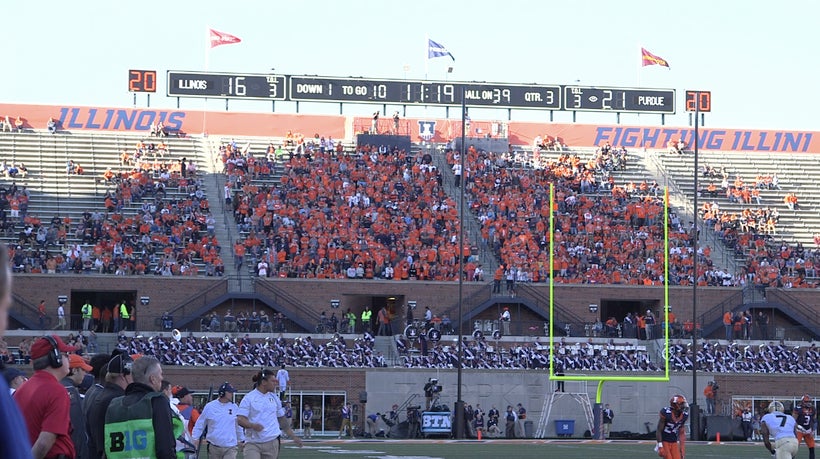
The student section in the Memorial Stadium north end zone, 2016. © 2016 Jay Rosenstein.
IT’S STILL THERE?
So why hasn’t anything been done about the fee? Mitch Dickey was as deeply involved in UI issues as just about any student could be. He finished his senior year, in 2015-16, as the UI Student Body President. Certainly he would be aware of the $34 per semester student fee for the renovations of the football stadium?
“No, I wasn’t,” he said. “(And) I’ve sat on the committees as well.”
Victor Rivera, another senior who has also served in student government, had a similar reaction. “I didn’t know this before today,” he replied. “And it’s frustrating now that I know it.”
One can forgive these students for having no knowledge of the fee. That’s because it isn’t listed in the “Tuition and Fee” section of university’s website. Nor does it appear on the students’ invoices.
The invoices sent from the U of I contain an itemized list of expenses (see below). These include charges such as tuition, housing, meal plan, etc., as well as a number of fees. But the $34 athletic fee is nowhere to be found.

A typical in-state student invoice, 2015-16
That’s because it is contained within a category called “General Fee.” And the individual expenses that make up the General Fee, such as the $34 athletic department fee, aren’t listed.
“We don’t … see a line item of everything, so we have no clue … where our money is going,” said current UI senior and student government member Patricia Rodriquez.
The one place students, and the public, can find out what the General Fee is for is on the Office of the Registrar’s section of the UI’s website. For the past several years, the explanation of the General Fee has read:
A fee to support certain fixed costs of fee-supported buildings (Activities and Recreation Center, Ice Arena, State Farm Center, Illini Union, etc.) on campus.
There’s no mention of the football stadium, Memorial Stadium, among the list of buildings. And the buildings that are listed are ones used primarily or significantly by students, unlike the football stadium. But the description does include the word “etc.,” which means that technically the fee could be used to support pretty much any campus building.
“It upsets me because why did someone see to write it this way in the first place?” asked Pius Weibel, a parent to a then-UI student. “Why present it in a form for people to wonder, what is it?”
There is one other place where the public can find information about the UI’s student fees: the website of the Illinois Board of Higher Education, or IBHE. The IBHE has detailed lists of the student fee costs for each of the state’s public universities. It even has a specific category for disclosing the amount of athletic fees, labeled “Athletic.” The two other campuses that are part of the University of Illinois System, in Chicago and in Springfield, both list their athletic fees in that category. But on the U of I, Urbana’s list of student fees, the “Athletic” category is blank.

From IBHE website
While not listing the fee may not seem like such a big deal, it is the difference between disclosing and not disclosing to the public that UI students are required to pay money to the athletic department. That could be particularly important when the U of I, Urbana signs a coach to a new multimillion-dollar contract, and the public wants to know where the athletic department money is coming from. As to why the “Athletic” category is blank, Robin Kaler, UI Associate Chancellor for Public Affairs answered, “I don’t know anything about the IBHE website.”
ONE LAST CHANCE
Whether they know about the athletic fee or not, students do have one official venue for input about their student fees: the Student Fee Advisory Committee or SFAC. SFAC consists of a majority of student members, and a few administrative members as well. The charge of the committee is to review student fees and make recommendations for any changes to the Vice Chancellor for Student Affairs.
That sounds like the perfect venue to reassess the athletic fee. But there’s a catch. SFAC is empowered to review every fee category, except one: the General Fee category, where the athletic fee resides.
According to an email from the current Associate Vice Chancellor for Student Affairs, because the General Fee consists mostly of debt service payments, “It would be inappropriate for members of SFAC to request a reduction,” he wrote. “Not meeting our financial obligations would have a significant impact in the short and long-term, including possibly downgrading our credit rating and reducing our ability for capital financing.”
But what about the opposite scenario, the very one that has taken place, where, the number of students has grown, so the amount collected from the fee is actually producing more revenue than necessary to meet the University’s debt obligations? “If a department were to collect more revenue than needed,” he replied in a follow-up email, “the University division within which they report would be responsible for assessing and addressing the issue.”
What that means is, in this case, it’s up to the athletic department to decide whether or not it wants to keep the extra money. But given the ever-escalating arms race for bigger and better stadiums and facilities that all big-time college athletic programs find themselves in, a return of any money is highly unlikely.
Chicago Sun-Times sportswriter Rick Telander puts it more bluntly. “There’s no amount of money that is too much for (an) athletic department. None.”
And so, the fee continues.
A NEW FEE SIBLING
In 2014, the original student athletic fee got a new partner: a $25 per semester student fee to help pay for a renovation of, naturally, the basketball stadium. That fee was also put to a student vote. Perhaps learning a lesson from the students’ vote against the 1997 fee, athletic department staff this time selected and trained students to lobby their fellow students for the fee, arming them with a list of talking points and nicely-produced print materials.
In a very close vote, the fee passed. Today, it too is locked safely within the walls of the General Fee, where students on the Student Fee Advisory Committee won’t ever be able to touch it. Although this time, the new fee has an expiration date – in thirty years.
The UI student athletic fees are on the lower side compared to the national average. That’s because UI is a member of the country’s wealthiest conference, the Big Ten, which currently subsidizes its teams to the tune of about $40 million per year. But for some UI students already in debt — and 66% of all college seniors in the state of Illinois graduate in debt, according to a 2015 study by the non-profit Institute for College Access and Success — that’s a small consolation.
“It’s really frustrating because there are all of these little costs that come with going to a university like this,” said current UI senior Patricia Rodriquez, a first generation college student. “For the students here who are just struggling to get by, it’s really tough.”
Jim Dey, a columnist for the Champaign News Gazette agrees. “Asking students to subsidize college sports is definitely a financial burden.”
But the fees continue.
WILL IT EVER END?
Thirty years from now, will anyone remember that the 2014 $25 student fee was supposed to sunset? Or will this fee too be shifted to pay for another athletic department expense, without anyone noticing? If past history is any indication, that’s exactly what’s bound to happen — unless someone can find a way to change course.
“Something that really needs to happen,” says former UI Student Body President Mitch Dickey, “is, let’s take a look at when these fees were created, why they were created and what … fiscal circumstances the athletic department was in and how that has changed, and what revenue share they should be paying or putting into this.”
While it might be a challenge for the UI athletic department to pick up all the expenses that students are currently paying, there’s plenty of proof that it can be done. According to a 2016 USA Today report, four of the fourteen schools in the Big Ten don’t charge any student fees for athletics.
One of those four is Purdue University. “A very small percentage … of our students can actually make it on to an intercollegiate team. Fewer than two percent,” said Mitch Daniels, Purdue’s president. “And I don’t think it’s right to tax the ninety-eight percent who won’t be able to play, many of whom aren’t that interested, to support the (athletic) program. So we draw that line here. And we’ve been able to live within it.”
And Purdue is able to do it even with the lowest total ticket revenue of all Big Ten schools in 2015-16, less than UI.
“The fact of the matter is, at some point there’s going to have to be a discussion,” agrees State Senator Scott Bennett. “At a time when faculty and staff aren’t getting raises, (when) money coming out of Springfield is less than it was before, you’re trying to figure out where you make up that money. And at the same time, athletics has additional money that they did not expect … it’s a bonus, it’s nicer seats, it’s higher paid coaches. So I think that‘s going to have to be part of the discussion, whether athletics shouldn’t (be allowed to) just take, but should also contribute some of this extra money.”
“The fact is that money is here. And I think we have to talk about the fairest way to divide that up going forward.”
That is, if anyone knows it’s there.
———————-
late follow-up: I reached out to the UI and asked why a detailed breakdown of student fees wasn’t available on the Office of the Registrar’s section of the UI website. Robin Kaler, Associate Chancellor for Public Affairs, answered: “No one knew why it wasn’t there already.” She indicated she had reached out to them to suggest adding that information.
———————-
authors note: UI is used to indicate the University of Illinois, Urbana campus.
Part Four
Low Income Pays For Luxury
by Jay Rosenstein
Imagine this: MAP grants, money from the state given specifically to help low income students pay for college, being used to pay for building luxury boxes at the U of I’s Memorial Stadium and State Farm Center.
Sound ridiculous?
It’s not. Because it’s true.
That’s just one of the findings of a multi-year investigation into the ways in which the University of Illinois, Urbana (UI) finances its athletic department.
So how could this happen?
The Monetary Award Program, or MAP grants are funds provided by the state of Illinois to help the state’s low-income students pay for college. It is an entirely need-based program; there are no additional qualifications other than the financial need of the students and their families.
Each year, as part of the budgeting process, the legislature determines how much total MAP money will be appropriated. The total pot of MAP money is limited — once it runs out, it’s out, regardless of how many students are still in need. And as tuition and fees at UI, as well as Illinois’ other public universities, have continued to rise, the need for MAP grants has grown.
“We give the money until there’s no money left,” said State Senator Scott Bennett, whose district includes UI, “and there’s still people with their hands out (who need) that money.”
But where do the luxury boxes come in?
According to Dan Mann, the director of financial aid at UI, MAP money is restricted to paying for tuition and fees. The students receive their semester bills, and “those charges are all put on an account that is in the student’s name,” he said.
The student’s bill includes charges for all mandatory fees, which includes the General Fee. Inside the General Fee are the fees used for paying off the loans for the renovations of the football and basketball stadiums, which were used for building luxury suites and premium seating. Think of it like a Russian doll of fees, each one nested inside another.
According to Mann, the student’s university bill then works just like a credit card bill. Payments don’t go towards specific items; they simply lower the total amount owed. When students receive financial aid, it works just like any other payment. “The financial aid they receive is put against that account,” said Mann.
So when MAP grants come in, the money is used to pay for everything — athletic stadium renovations included.
“The problem … is, that means that money which I think everybody assumes is going toward the cost of tuition would also go in some part to those fees which include athletic facilities,” said State Senator Scott Bennett. “I think that would really surprise legislators who really fight for this money.”
Of course, the new suites and premium seating serve a purpose other than just allowing a few fans to sit in luxury. They also generate additional revenue through their sales. But that revenue doesn’t go to the university; it all goes to athletics. Athletics then uses the additional revenue to hire more staff, pay coaches more money, and build and remodel even more facilities. Which then, they hope, generates even more revenue, all of which again goes to athletics.
And round and round it goes.
Many people argue that these improvements help the teams win more games, which in turn, they say, will produce more money for the university by way of increased donations. But that’s a myth that was long ago debunked by researchers.
“The studies we have on it do not sustain a clear relationship between athletic success and donations (to the institution),” said Andrew Zimbalist, a professor of sports economics at Smith College.
But there are aspects of the renovations that do provide something for the students. Everyone, students and non-students alike, shares in the enjoyment of new scoreboards, more concession stands, and in the case of the basketball stadium, new seats throughout. But in order to take advantage of those benefits, which every student is paying for, a student also has to buy a ticket to a game.
In other words, students have to spend more money to get any benefit from the money they are already being forced to spend.
That creates an additional hurdle for MAP grant recipients. “If they can’t pay for their own tuition, or at least they’re eligible for MAP,” said State Senator Scott Bennett, “they’re the least likely to actually have any money to go to athletic events.”
So how much MAP money are we talking about here? Calculating that is a little tricky and requires making a few assumptions. As economist Zimbalist said in a 2015 Washington Post story, it isn’t as simple as saying, “when I bought my ticket to see the Maryland game, (my money) went to coaches’ salary, but when you bought a ticket, it paid the tutors.”
To determine how much MAP money is going toward the stadium renovations, Zimbalist recommends splitting all the expenses proportionally: whatever percentage of the student’s total tuition and fee costs are going to athletic fees, that’s the percentage of every MAP dollar that goes towards those fees.
Complicating the calculations further is the fact that in-state tuition is different depending on the student’s major. But, skipping over the nitty-gritty math details (the more mathematically inclined will find them below*), using the numbers from 2016-17, the total amount of MAP funds that went to support athletics that year was approximately $300,000.
Of course, you could do the same sort of calculations and detail how much MAP money is going to every other fee, and then critique those too. But there is a big difference between every other student fee and the athletic fees: the athletic fees go to pay for things that aren’t primarily, if at all, for students’ use.
So why is this a problem? One reason is that about half of all students eligible for need-based tuition help from MAP funds didn’t receive it due to a lack of available MAP money, according to a study by the Partnership for College Completion using 2014 data. In short, more MAP money is needed, and every dollar spent on non-essential college expenses — luxury seating that students can’t afford probably qualifies — would help.
“We’re pushing for MAP grants, we’re fighting for the university to keep its tuition low, and now we’re saying, once you get there, you’re still going to have debt that has to go to make sure the doctors in town and other people can sit in the luxury boxes,” said State Senator Scott Bennett. “I think that (leaves) a bad taste in everybody’s mouth.”
Author’s note: UI is used to indicate the University of Illinois, Urbana campus
—————————
* THE MATH (all based on academic year 2016-17 numbers)
In-state tuition varies between $12,036 for base tuition, to $17,040 for highest cost programs. The average then is $14,538.
Mandatory fees = $3,832.
Total tuition and fees = $18,370; Fees = 20.9% of total.
Students pay $68 in fees towards Memorial Stadium, and $212.30 towards the State Farm Center. However, the State Farm Center is a shared facility; only half of it is for athletics. Therefore only half of the State Farm Center Fees, $106.15, are used in the calculation.
Total fees towards athletics = $68 + $106.15 = $174.15 = 4.5% of total fees.
$30 million in MAP grant funds were provided to UI.
Total MAP grants to athletics (2016–17) = $282,150
Fascinating work!
Question: Do you have a sense of the ways that Illinois is similar to or different than other states, in significant ways that are relevant to public funding and athletic programs as discussed here?
I ask because 1) I live in Kentucky and 2) we are in the midst of significant wrangling over an underfunded state pension system. So, if there are some fat pensions for coaches weighing us down and the legislature is proposing modifying their obligations to K-12 public school teachers, that would be big news.
Thanks for any insight on this!